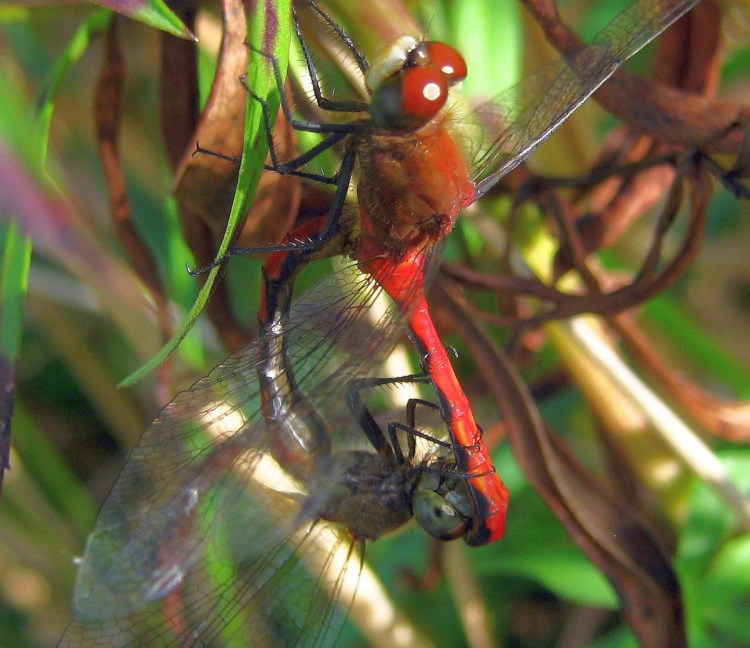A few months ago, a study showing a steep decline in airborne insects in Germany ticked my uneasy buttons and got me wondering about anecdotal observations of bug declines in Maine. A number of readers responded, saying they too had noticed dropoffs in, for an oft-repeated example, moths on summer evenings. This year, for the third or fourth summer in a row, we are again seeing hardly any moths in the deck light compared to the swarms we used to have in Troy. So I remain concerned. But.
A couple of reader anecdotes.
Earlier this month, Joan in Skowhegan wrote:
“Earlier this week I was treated to several dragonfly performances in my backyard. Around 6 p.m. somewhere between 15 and 25 dragonflies were in constant motion just a few yards from my back door. I put a chair out in their midst and watched. They did not land and it was hard to tell if they were catching anything as they are so fast. I watched for half an hour and they never stopped. This took place for two or three more times. What’s up?”
So I replied:
“It’s heartening to hear of someone seeing dragonflies for a change, instead of wondering why they’re not seeing them.
“In our yard in Troy, which is enclosed by woods, we used to see dozens of dragonflies doing the same thing you describe every evening from June into September. It was a great show, like you say. But in the past three or four summers, we see only one or two or three at a time, sporadically. The same has been true at the nearby Unity park where I walk all the time — the reed canary grass used to be practically aswarm with dragonflies and damselflies all summer, but recently they’re practically absent. I’ve heard similar stories from other readers. I’ve asked entomologists about this, but they’re reluctant to make pronouncements because no one has made a formal study to find out if there is really a decline, or we are just seeing isolated instances of, for example, low egg-hatching rates.”
If my dearth of dragonflies in recent summers is an isolated glitch, as one entomologist told me is entirely possible, and the appearance of Joan’s dragonflies is still typical, then maybe my concerns are overblown. Who knows? The last few weeks we’ve been seeing white admiral and mourning cloak butterflies around the yard in more numbers than recent years, too.
On another note, earlier this summer a property owner on McGrath Pond in Oakland wrote to George Smith and me saying that in recent years he’s seen hardly any snakes, where decades ago he used to see them frequently all summer. Lew’s question, like Joan’s, was: “What’s up?” He wondered if this scarcity could be an effect of climate change.
“In all fairness,” he said, “possible increases in natural predation, as well as climate change, must also be considered. There were no eagles or ospreys here back in those days. Both populations have recovered remarkably, with at least two active eagle nests on McGrath Pond and Salmon Lake.”
I replied that I’ve been seeing snakes with about the same frequency as ever in Troy. Over the next few weeks, I kept a more careful eye on the ground and have seen more frogs than usual, mostly pickerel frogs, I think. A big frog population, even if it’s just in my backyard, seems encouraging. I contacted the Maine Herpetological Society to ask if they’ve noticed anything unusual with snakes.
Good news: Two members said they have not heard of or observed any dropoff in snake sightings in Maine. In fact, Doug Kranich in Millinocket said he’s seeing as many garter snakes as ever. And this summer, he said, “I discovered a place where (green snakes) are locally abundant and have seen more in the last two months than I did in 38 years total.”
It’s hard to know what to realistically make of any of this. Anecdotally, it seems a lot like the woods here are changing. Note Lew’s observation that eagles and ospreys are locally more common. And then there is the scientifically verified explosion in ticks.
On the other hand, one person’s backyard observation is insufficient evidence of anything general, except in that one location at that one time. In the ancient art of rhetoric, making a general statement based on just one or two examples is called false induction, or generalizing from insufficient evidence. And it seems to be epidemic nowadays.
The fact that I keep not seeing dragonflies is meaningless generally; it might be an example of something larger only when joined to other observations, including Joan’s, and then carefully analyzed. Lew’s failure to spot snakes only means that he’s not spotting snakes in his area; his observation might mean something larger only when joined to many other carefully analyzed observations, including Doug’s green snakes.
The fact that it’s been unusually hot and humid this summer means nothing by itself about global warming. It’s when you put it with the temperature and humidity averages of the past, say, 25 years that an accurate generality might emerge. We will have to be counting the dragonflies and snakes the same way to make any generalizations verifiably attached to reality.
Joan’s and Doug’s observations are heartening.
Still, it all makes me uncomfortable. The four warmest years ever recorded on Earth were, in order, 2016, 2015, 2017 and 2014. Thousands of scientists say the same thing: Global warming is upon us. And where have my dragonflies and moths gone?
Dana Wilde lives in Troy. You can contact him at naturalist1@dwildepress.net. His recent book is “Summer to Fall: Notes and Numina from the Maine Woods.” Backyard Naturalist appears the second and fourth Thursdays each month.
Send questions/comments to the editors.



Comments are no longer available on this story